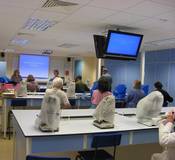


Menu

Search the PDAS site


Archaeology
Workshop Reports
The macrofossils are also analysed using a low powered microscope and which contain such material as cereal grain, twigs, bone or seeds. This material is crucial; in that it is in-
Pollen analysis workshop
(click to enlarge)
There are factors, however, which can affect pollen readings. Contamination of the site, as for example, the red dust that covered the country some years ago that had travelled many hundreds of miles, upsets a pollen sequence. Pollen in bogs may have been blown in from some distance; not all plants produce a lot of pollen; and differences between the aquatic pollen and wind borne pollen in a lake, can have a skewed result, with an increase in the number of aquatic pollens outweighing the airborne ones. Continued ...
A brief glimpse of the microscopic world of pollen.
An excellent PDAS training day was held at the University of Plymouth in April, under the tutorship of Ann Kelly, Science Officer in the School of Geography. Ann looked at the role of pollen analysis in archaeology.
Pollen was first recognised at the beginning of the 20th century by Lennart von Post, using a simple microscope with a natural light source, and pollen analysis was later to be used by a wide range of people from archaeologists, apiarists and geologists to environmental scientists, paleoenvironmentalists and forensic scientists.
In archaeology, pollen analysis is used as a tool to estimate an approximate date of sequence, and to help reconstruct the context of an environment surrounding a site looking at the type and number of samples found.
In soil, preservation of pollen is often poor owing to the air content within the soil, but in anaerobic conditions such as a peat bog, pollen is relatively well preserved. To be able to define a stratigraphical sequence of a site, samples may be taken by using a variety of coring methods which vary according to the condition of the ground being tested, but surface samples can be taken merely by using a spatula. Very often, samples from the surrounding ground may also be taken for analysis, as pollen is easily transported by wind or animal movement across the ground surface.
Once samples have been collected, they are removed to the laboratory for analysis. Very often the core sample may be described by the Troels and Smith (1955) method whereby the core is sampled according to the visible evidence it contains, for instance, an obvious over-
The samples removed from the cores then go through a series of chemical preparations which are quite complex. Once suspended in solution, the solution is passed through a series of sieves, in which microfossils are separated from the pollen and spores, and a marker dye saffronin added to make pollen identification easier. The prepared pollen is then suspended in glycerol or silicon oil and mounted on a microscope slide in preparation for identification and counting the grains.

| January |
| February |
| March |
| April |
| May |
| June |
| July |
| August |
| Septmber |
| October |
| November |
| December |
| Pollen Analysis |
| Archaeology of Gardens |
| Identifying Prehistoric Pottery |